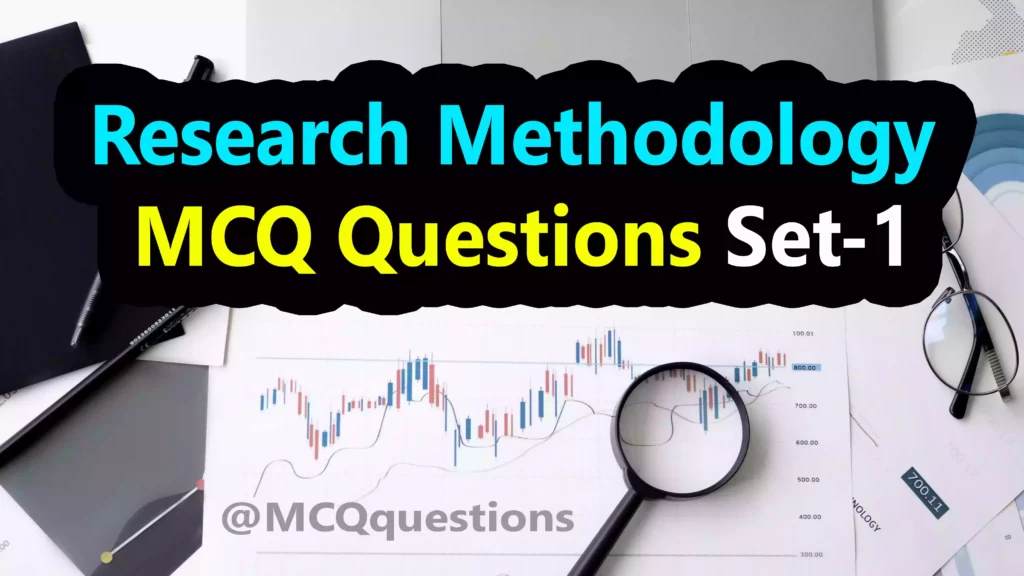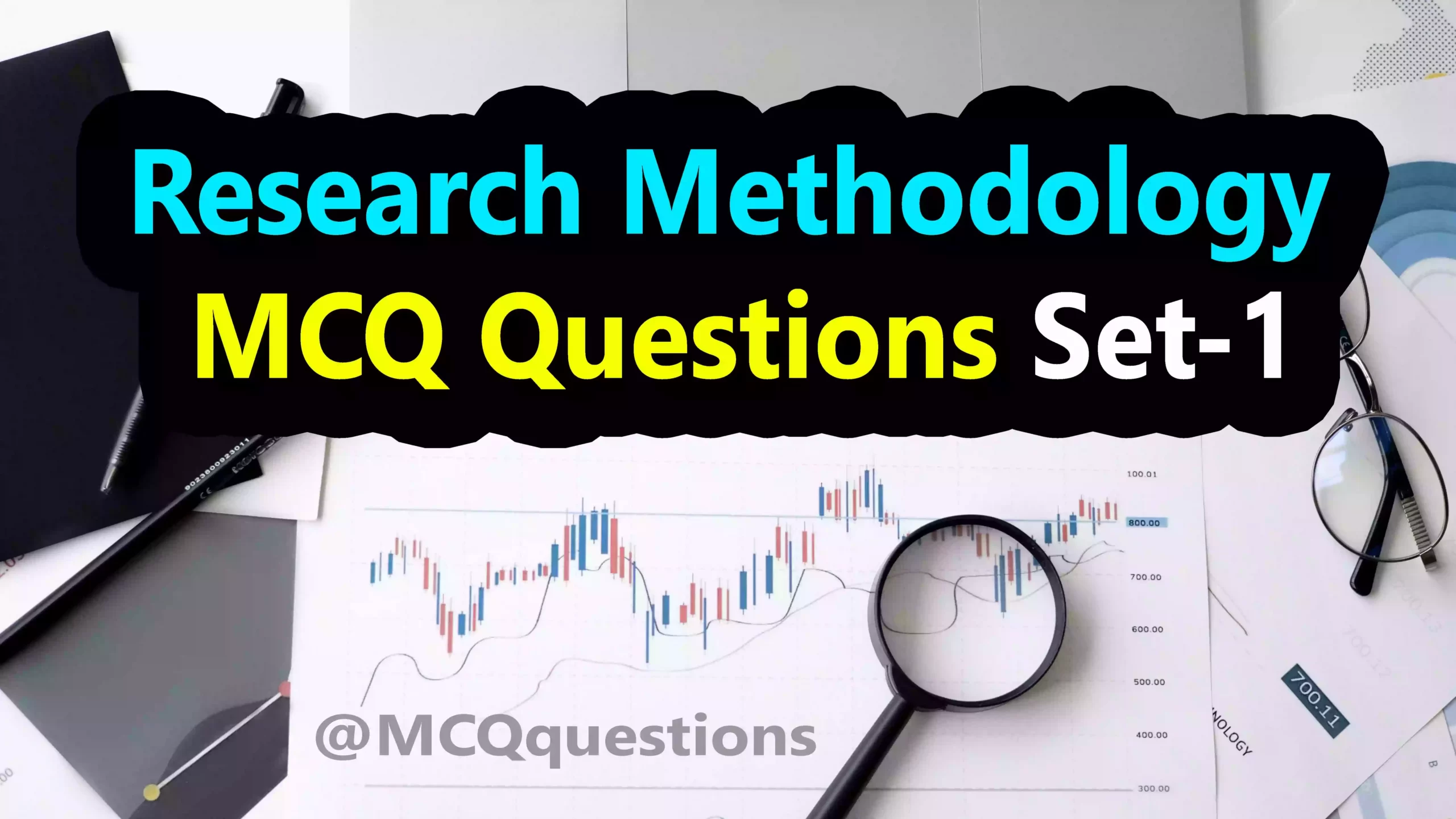Research Methodology MCQ

Research Methodology MCQ
Also you can read
1. In “RESEARCH” “R” means
(A) Role
(B) Retain
(C) Relly
(D) Round
Answer (B) Retain
2. In the word “RESEARCH” “A” means
(A) Articulate
(B) Artist
(C) Article
(D) None of the above
Answer (A) Articulate
3. Research is derived from
(A) Latin
(B) Indian
(C) Greek
(D) Japanizes
Answer (A) Latin
4. Who defined “Research” as “systematized effort to gain new knowledge”
(A)Tom & Zerry
(B) Redman and Mory
(C) F.W Taylor
(D) Ross Taylor
Answer (B) Redman and Mory
5. Which of the following is the Objective of the Research?
(A) To become familiar with a phenomenon
(B) To test a hypothesis of a causal relationship between variables
(C)To determine the frequency with which something occurs or with it is associated with something else.
(D) All of the above
Answer (D) All of the above
6. Research is basically
(A) a methodology of enquiry
(B) search of truth
(C) a systematic exploration of facts
(D) All of the above
Answer (D) All of the above
7. A test of research aptitude for candidates of the UGC NET, is aimed at
(A) providing basic idea of search to the candidates
(B) Screening the persons having scientific bent of mind
(C) providing a database of ‘future’ scientists of the country to the Government
(D) putting obstacles to the candidates
Answer (B) Screening the persons having scientific bent of mind
8. The main purpose of research in education is to
(A)-help in individual’s personal growth
(B) increase the social prestige of an individual
(C) increase individual’s market value of jobs
(D) help the individual to become an eminent educationist
Answer (A)-help in individual's personal growth
9. Where is the objective observation used?
(A) In conducting experiments
(B) In research
(C) In normal behaviour
(D) In almost all the situations
Answer (A) In conducting experiments
10. Inferring about the whole population on on the basis of the observations made on a small part is called
(A) deductive inference
(B) inductive inference
(C) objective inference
(D) pseudo-inference
Answer (B) inductive inference
11. A hypothesis is a
(A) Tentative statement whose validity is still to be tested
(B) Supposition which is based on the past experiences
(C) Statement of fact
(D) All of the above
Answer (A) Tentative statement whose validity is still to be tested
12. What do you mean by synopsis of a research project?
(A) The blue print of research
(B) Extracts from the research observations
(C) A plan of the research
(D) Summary of the findings of the research
Answer (D) Summary of the findings of the research
13. Can a problem be stated?
(A) By putting forward a question
(B) Making a statment which is declarative in nature
(C) Both ‘A’ and ‘B’
(D) None of the above
Answer (A) By putting forward a question
14. What do you mean by an assumption?
(A) It is a framework in which research work has to be done
(B) It simplifies the logical process of arriving at the solution
(C) It is a restrictive condition
(D) None of the above
Answer (B) It simplifies the logical process of arriving at the solution
15. A null hypothesis is
(A) hypothesis of no difference
(B) Hypothesis that assigns value of zero to the variable
(C) Hypothesis of zero significance
(D) None of the above
Answer (A) hypothesis of no difference
16. The preparation of a synopsis is
(A) an art
(B) a science
(C) Both ‘A’ and ‘B’
(D) None of these
Answer (C) Both 'A' and 'B'
17. The advantage of sampling is
(A) time-saving
(B) capital-saving
(C) increased accurary
(D) Both ‘A’ and ‘B’
Answer (D) Both 'A' and 'B'
18. In case of destructive testings, the best method of research is
(A) Sampling
(B) Complete enumeration
(C) Census survey
(D) None of the above
Answer (A) Sampling
19. The method of Randomization involves
(A) lottery
(B) Coin method
(C) Tippit’s table of random digits
(D)All of the above
Answer (D) All of the above
20. The advantages of random sampling is that
(A) It is free from personal biases
(B) It produces reasonably accurate results
(C) It is an economical method of data. Collection
(D) All of the above
Answer (D) All of the above
21. Tippit table is
(A) A table of random digits
(B) Used in statistical investigations
(C) Used in sampling methods
(D) All of the above
Answer (D) All of the above
22. The demerits of sampling methods is
(A) Existence of sampling errors
(B) Requirements of adequately trained personnel for sample survey
(C) Non-uniformity in sample units
(D) All of the above
Answer (D) All of the above
23. What is the meaning of Randomization?
(A) Each and every unit of the population has an equal chance of selection in the sample
(B) The selection or non-selection of a unit of population does not affect the selection or non-selection of the other unit of the population in the sample
(C) It is a method of selection which is free from subjective biases.
(D) All of the above
Answer (D) All of the above
24. Type-1 Error occurs when
(A) The null hypothesis is rejected even when it is true
(B) The null hypothesis is accepted even when it is false
(C) The null hypothesis as well as Alternative hypothesis, both are rejected
(D) None of the above
Answer (A) The null hypothesis is rejected even when it is true
25. What is/are the base(s) of formulation of a Hypothesis?
(A) Reflection
(B) Deduction
(C) Observation
(D) All of these
Answer (D) All of these

Thank you for making learning research easy